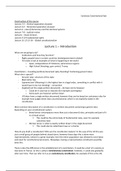College aantekeningen
Complete summary Constitutional Law (all lectures)
- Instelling
- Tilburg University (UVT)
This document is a comprehensive summary of all lectures. With extensive notes on both readings and cases discussed in class. The student received 8/10 as a final grade.
[Meer zien]




